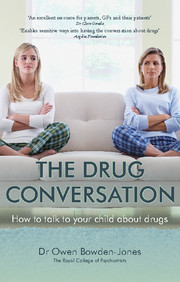Book contents
- Frontmatter
- Contents
- Acknowledgements
- Introduction
- 1 What are psychoactive drugs, who uses them and why?
- 2 Drug use and adolescence
- 3 Having the drug conversation with your child
- 4 Drugs and the brain
- 5 Types of drugs
- 6 Rise of the synthetics
- 7 Detecting drug use and what to do about it
- 8 Treatment and recovery
- 9 Final thoughts
- Appendix
- References
- Index
5 - Types of drugs
Published online by Cambridge University Press: 01 January 2018
- Frontmatter
- Contents
- Acknowledgements
- Introduction
- 1 What are psychoactive drugs, who uses them and why?
- 2 Drug use and adolescence
- 3 Having the drug conversation with your child
- 4 Drugs and the brain
- 5 Types of drugs
- 6 Rise of the synthetics
- 7 Detecting drug use and what to do about it
- 8 Treatment and recovery
- 9 Final thoughts
- Appendix
- References
- Index
Summary
To have a meaningful conversation with your child about drugs, you need to be confident that you have enough information about the different drugs, how they're used, what effects they cause and the risks they carry. This chapter will focus on the key knowledge you need in order to plan the drug conversation.
Psychoactive drugs cause their dramatic effects by influencing the messaging between nerves in the brain. Different drugs work through different receptors to cause particular effects on feelings and behaviours. A strong cup of coffee makes us feel alert and energised, whereas too much alcohol makes us feel sleepy and tired. This is because caffeine works by stimulating the brain, whereas alcohol causes sedation. Knowing the types of drugs is important, because it helps us understand the risks associated with them.
You will have heard of some drugs, for example heroin, cocaine or cannabis. But in addition to these well-known drugs, there are hundreds of more obscure drugs available, sometimes better known by their brand names.
Psychoactive drugs can be broadly classified into four groups according to their primary effect:
• stimulating
• sedating
• hallucinogenic
• dissociative.
In most cases, the name of a drug gives away little about its probable effects when consumed. Some drugs have more than one effect (Fig. 5.1) or different effects at certain doses. For example, ecstasy (MDMA) has both stimulant and hallucinogenic properties, while ketamine can cause euphoria at lower doses but is sedating at higher doses. Box 5.1 shows the most common drugs within each group.
Key messages
• Psychoactive drugs can be divided into four broad groups according to their effect.
• Stimulants, such as cocaine, cause euphoria and alertness.
• Sedatives, such as cannabis, cause relaxation and calm.
• Hallucinogens, such as LSD, cause hallucinations.
• Dissociatives, such as ketamine, cause ‘out-of-body’ experiences.
Stimulants
What are stimulant drugs?
As the name suggests, stimulant drugs cause a person to feel alert and energetic, increase concentration and reduce fatigue. Stimulants can also produce powerful feelings of euphoria and well-being. As well as their psychoactive effects, stimulants can produce powerful physical effects, such as a racing heart rate, increased blood pressure and a reduced need to sleep and eat.
- Type
- Chapter
- Information
- The Drug Conversation , pp. 81 - 112Publisher: Royal College of PsychiatristsPrint publication year: 2016



